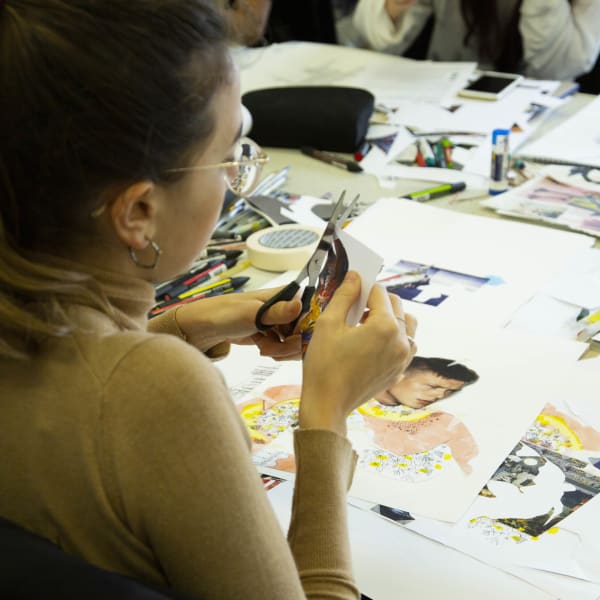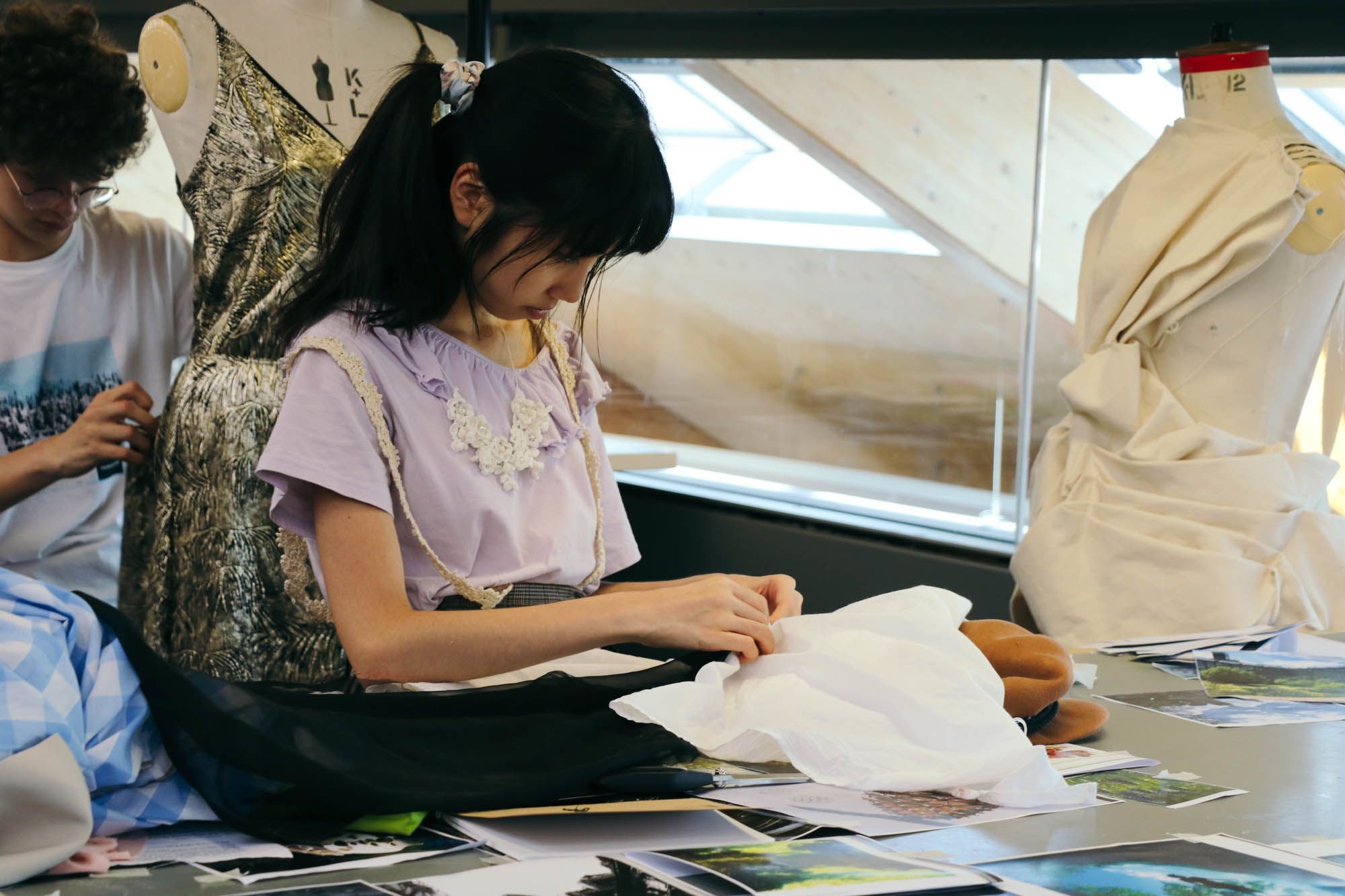
What does a fashion designer do?

- Written byCarys Thomas
- Published date 28 February 2022

The fashion industry contributed as much as £32.3 billion to the UK economy in 2017 according to data published by the British Fashion Council. This exciting industry is growing rapidly and continues to be a major UK employer, meaning that talented fashion designers are very much in demand.
Consumers are also becoming increasingly aware of the environmental impact of fashion and there is mounting pressure on the industry to prioritise sustainable materials, fabrics and working practices. Skilled fashion designers with an eye for detail and an interest in the issues facing the industry are now needed more than ever before.
Are you interested in a career in fashion design? We spoke to fashion designer and UAL short course tutor, Carlyn McGuire, to find out more about the role of a fashion designer. Carlyn runs our Fashion Design Intensive Short Course at London College of Fashion, which is designed to provide an introduction to the principles of fashion design with a focus on the development of ideas from well-explored research. We’ll discuss why this is such an exciting time to be a part of the fashion industry, and what kind of skills or qualities a fashion designer should have.
This guide is designed to offer a practical insight into the world of fashion design and will include some useful tips on how to break into the industry for those just starting out. Read more about how to get started in our guide on how to start a career in fashion.
What is a fashion designer?
Fashion designers use their advanced technical skills and creativity to develop new women's, men’s, and children’s apparel. Drawing inspiration from current fashion trends and consumer needs, they will sketch out ideas and decide on the fabrics, colours and patterns that shape a garment. They will often have a specific brief to work towards and may specialise in a particular kind of clothing, such as sportswear or formalwear.
“Being a fashion designer is not a one size fits all career,” says Carlyn, “there are many ways to be a designer and it all depends on what you want or where you want to be in the fashion industry.”
Fashion designers are involved in every part of the design process, which often takes several months to go from an initial concept to final production. Designers must research current trends and refer to fashion trade reports which provide information on the styles, colours and fabrics that may be popular at any one time. They will also be required to source fabrics and organise samples to get an idea of what will work best for a particular piece.
During the planning stage, fashion designers will generally begin by sketching out designs. They may use computer-aided design (CAD) to experiment with different colours and shapes using lifelike virtual models, or they may prefer to sketch by hand and transfer prototypes onto a computer to make edits. This sketch will then be used to develop a rough model of the design to show how the finished piece may look.
Smaller design houses or firms may require fashion designers to produce the patterns and sew the prototypes themselves, while larger companies will sometimes have their own tailors to bring designs to life.
Types of fashion designer
“There are so many various design directions and all offer a different experience and working life,” Carlyn explains, “but ultimately a fashion designer will be responsible for creating and developing new and exciting fashion ideas and designs for whatever direction they are in; working alone or within a team of designers, creating mood boards, following trends, creating concepts for new ranges or collections, working with sample machinists, sourcing fabrics etc.”
Although there are numerous different specialisms, many fashion designers work within three main areas:
- High street fashion: High street fashion is a commercial, media-led area of fashion that is primarily focused on clothing that is designed to be mass- produced. The design process is often informed by seasonal trends and fashion catwalks. Designers that work in this area must create apparel for a general and broad audience.
- Ready-to-wear: These professionals are also known as pret-a-porter designers, and are required to create ready-to-wear collections which are usually produced on a relatively small scale. They will generally create outfits according to the specific material, presentation or cut that customers request.
- Haute couture: Fashion designers that specialise in haute couture create customised, one-of-a-kind apparel that may be used for the catwalk. The production process generally takes a little longer, and finished designs are usually expected to endorse a particular brand and create a strong look that may act as a source of inspiration.
What skills does a fashion designer need to have?
“A fashion designer needs to be innovative,” Carlyn says, “fashion follows trends that we often see on the high street, however when we look at the runway or in fashion magazines, we often see fashion that is dramatic, exciting and not trend-led, and this is where the ideas and concepts of a fashion designer are evident. A fashion designer can be inspired by almost anything to create a collection.”
Fashion designers must be able to demonstrate creativity, confidence and innovation. They should be imaginative and have the ability to generate new and original ideas. They’ll need strong design and technical skills including pattern cutting and sewing, as well as knowledge of design software. Good time management and organisational skills are also essential.
Why choose a career in fashion design?
We asked Carlyn what she thinks makes fashion design such an exciting area to work in: “fashion design is an art form” she said, “we teach students to deconstruct and reconstruct concepts and inspiration through process and techniques to develop dynamic and original fashion design.”
“It is exciting to watch the creative process develop and unfold. Nothing can be more exciting than seeing those ideas and outcomes come to life in fabric - what was once a drawing on paper! Fashion designing is only one part of the process; making it happen is amazing to see and as a tutor, nothing fills me with more pride than seeing my students follow through on their ambition and create what they designed when they were studying on my course.”
Breaking into the fashion industry
The fashion design industry is very competitive, so aspiring designers need to prove that they have the knowledge and experience needed to succeed in the area. Relevant academic qualifications in fashion design or fashion business, marketing and communication would be helpful.
Work experience is vital for professional growth and can be a great way to develop a network of useful contacts within the fashion industry. It is important to remember that there are many ways to enter the industry - Alexander McQueen left school at 16 to become an apprentice on Mayfair’s Savile Row, the historic centre of British menswear.
Carlyn recommends developing a portfolio to demonstrate your talents: “learn the skills you need to build a portfolio that will help support your ambition. If you want to design garments with concept and innovation then learn some design techniques and processes. If you want to design print then consider taking a print course. Explore different skills through short courses to investigate where your interests really are.”
You’ll need courage, passion and perseverance to find a path for yourself in this dynamic industry. For those willing to take the leap, studies have shown that a career in fashion can be incredibly rewarding - surveys suggest that fashion designers rate their happiness above average, putting them in the top 24% of careers.
If you’re interested in finding out more, you may like to explore some of our fashion design short courses, which include classes on womenswear, menswear, lingerie, footwear and accessories, amongst others.
